Hello, hello!
When October was over and November began, it was time for another month’s update on my travels. I stayed rather busy for most of November, though, so this is more of an October and November summary. If you didn’t read the last one or don’t remember, I’m studying at Westfield House in Cambridge and travelling as much as I possibly can for the time I have here.
I’ve been here long enough to change my spellcheck to British English, so enjoy words like artefact and organise 😉
On 15 October, I had my most relaxing trip, one organised by Westfield House – so I didn’t have to worry about sorting my own transportation or anything! This was a day trip from Cambridge to Stonehenge and Bath, both of which have incredible histories.
After leaving Cambridge by tour bus at around 07:45, we got to Stonehenge around 11:15. Stonehenge, of course, is a monument with the current stones set up around 2500BC, but with pits and some archaeological finds dating back much further. It was fascinating hearing about the ideas as to why the monument exists, what it was for, and more; everything about it, of course, being speculation based on what archaeologists and historians can piece together from the many artefacts found. We spent a couple of hours at Stonehenge before leaving for Bath. (No, I didn’t just look at big rocks for two hours – there’s also a museum.)
Bath is a beautiful city named and known mainly for being the site of some of the most well-preserved original Roman public baths in the world, though it’s worth noting that this doesn’t mean there’s a particularly large amount of original Roman structure left. The city is also fascinating for its design (much of the city being designed and planned by a single architect) and more recent history, including famous residents and frequenters such as Jane Austen and Charles Dickens.
After a few hours at Bath, we took the bus back to Cambridge and got back to Westfield House around 22:00.
The following weekend was another trip organised of the students, by the students, for the students (see, I’ve not turned completely British) – Canterbury and Dover. On Friday the 20th, I got out of class in the afternoon and completed the hurried trip back to the dorm to pack before rushing to city centre to the train station for the three-hour ride to Canterbury.
The Canterbury trip consisted of myself, Simeon Klepac (a Valpo friend), Moira (a Valpo friend who is actually studying in Ireland this semester but came over to join us for the weekend), and six other students from Westfield House. After dropping our bags off at our hostel in Canterbury, we had dinner at an excellent little restaurant in town. I realise you’ve never seen photos of the other people I’m studying with, so here’s that particular group of us:
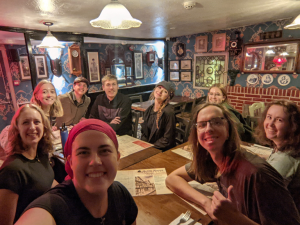
(Clockwise, starting at the person with the camera: Moira, Camille, Jillian, Joshua, Jackson, Gracie, Ellie, Bekki, Simeon)
Photo by: CY-BY-SA
After a good night’s sleep at the hostel, we took a bus the next morning out to Dover, a town directly on the English Channel and known for its chalk cliffs. We visited the water first thing so we could all touch the English Channel (because you can’t visit a coastal city and not touch the water), then did a nice hike along the top of the cliffs before climbing down a steep switchback trail to the bottom of the cliffs. The weather was downright awful, blowing rain at us pretty much horizontally and making just keeping our eyes open quite the challenge! At the bottom of the cliff face, though, the wind and rain were less and I was able to get some good photos of the cliffs. After hanging out at the bottom of the cliffs for a while, we made the arduous journey back to the top and hiked back along the very wet footpath (again in driving rain) into the city of Dover. After getting a quick lunch at a café in town, we split up – some people stayed in town to browse the shops, and the more interesting of us went to the Dover Castle, an awesome castle at which we spent as much time as possible before we had to head back to city centre for the bus back to Canterbury, from where some people would pick up their bags from the hostel (they had stored them in lockers for the day) and we would depart back to Cambridge.
The lockers ended up being a rather fun story! Apparently, Simeon (who had been tasked with stuffing all the bags possible into one locker) did too good a job packing the locker tight, and it wouldn’t open again. The attendant at the front desk of the hostel tried for a long time to get it open, but to no avail. After quite some time waiting, we got excellent news: the hostel manager had approved the use of such tools as a hammer or crow bar to open the locker. Several of my friends rushed down to the locker room to watch as Simeon broke into the locker, and from upstairs the rest of us heard a “pop” and loud cheering. Our bags were back!
Presumably the locker was broken, but hopefully they’ll be able to get it repaired and it won’t be too much of a problem.
That Tuesday night, I found myself with an unexpected conundrum: I had no plans for Wednesday. Now, this is fairly standard for me here – I don’t have Wednesday classes most weeks, but everyone else does, so there aren’t trips being planned and I end up doing things like laundry and cleaning that day. That week, though, I wanted to get out on Wednesday. So, I booked a train for early the next morning and charged my camera battery: it was time to visit Ely.
Ely is the next notable town North of Cambridge. It’s about 15 minutes away by train (not counting the 45-minute walk to the train station from Westfield House), which makes it a perfect place to visit on a random Wednesday. But why visit a town roughly the same size as Logansport? (No offence to Logansport, of course.)
First, it’s important to know that Cambridge has no cathedral – rather, it has college chapels (many) and churches (also many). Chapels such as those of the colleges of Cambridge, though, can’t just stand alone. They have to be headed by a cathedral. Somehow, the cathedral that oversees the entire Cambridgeshire region (similar to a county in the US) is in the tiny town of Ely, thanks to history I won’t get into, dating back to the 600s AD. It’s very fascinating! Anyway, the cathedral at Ely is one of the best cathedrals in England, including a very unique octagonal tower (built because the original square tower collapsed in 1322). I made it to the cathedral for the 7:30 morning prayer service, walked around town a bit, and then returned to the cathedral and stayed until after 15:00, admiring the building and learning about its history and the history of the region. After spending nearly eight hours there, I decided Ely was my favourite cathedral of England.
The next day was Thursday, and I once again didn’t have any classes, which made it a perfect day to go see a Shakespeare play (Macbeth) at the Globe in London with some friends. Obviously, we’d booked tickets quite a long time in advance, but the weather turned out perfectly – it was supposed to rain, but it held off the entire time we were in London. This was good, because the Globe has no roof over most of the area, and we had yard tickets – that is, we were standing (for the entire duration of the play) right by the stage – a very cool experience!
The next weekend was lighter, with just a short trip to London for a concert for my World Music class. The weekend after that, though, included some of the best hiking England has given us yet! On Friday, 3 November, I once again rushed back from classes to pack and get to the train station for a train to Windermere, in England’s Lake District.
Some background on trains in England. When travelling from Cambridge to London, the trains are pretty much perfectly reliable. Usually, one can get tickets for a train directly from Cambridge to King’s Cross in London, unless track maintenance is being done, in which case part of the trip might be by bus (but the extra cost is covered by the train companies). When travelling North, though, things can be different. There are fewer rail lines and fewer trains (meaning fewer times per day), so it’s nearly always necessary to change trains at least a couple of times. When booking tickets online, the website figures that all out for you, so you don’t have to figure out time tables on your own. For this trip, we had a train down to London’s Euston station, then one to Lancaster, another to Oxenholme, and a final one to Windermere. The problem with changes like these is that, if one train is late, you risk missing the next one.
Well, while we were happily on the train between Euston and Lancaster, there was an announcement that the train would be terminating at Preston instead of continuing to our stop due to someone being hit by a train earlier that day. We had to wait for the next train to Lancaster, which made us miss the next trains. Thankfully, ours hadn’t been the last trains of the day, so we were able to get on later trains and make it to Windermere – later than expected, but still the same day! Train trouble wasn’t over, though. Hold that thought.
On Saturday, we took a bus out to Keswick, and then from there to a hike along the Cat’s Bells peaks. This was the best hike of England, I think. The weather was pretty good, the views were incredible, and it even had some sections where we were basically bouldering our way up the rocky slopes.
After a nearly 5 hour hike, we took a bus back to Keswick, where Simeon and I went to the Derwent Pencil Museum. Keswick is the site of the world’s first-discovered graphite deposit (and remains one of only two known similarly large deposits of pure graphite), and thus is also the location of the invention of the graphite pencil. Naturally, we had to visit. Turns out, pencils have a rather interesting history! The Derwent pencil factory (where the museum was) also has very interesting history, especially around WWII, when the British government had them make some special pencils for spies going to enemy regions. These ingenious No. 2 pencils had a graphite tip on one end to make them seem like a normal pencil, but inside they contained a map and a tiny compass. Fascinating!
That evening, we went and visited Castlerigg, a stone circle similar to Stonehenge, but older – around 4500 years old, and showing its age. After watching the sunset from there, we returned to Ambleside where our hostel was.
Sunday, we started by heading out to Wray Castle, which is cool because it’s a castle. Only the first floor was open, and very empty, but it was still very neat! After travelling back to Windermere, we visited the Jetty Museum, which included lots of historical boats from the one owned by Beatrix Potter (writer of Peter Rabbit) around 1890 to Trimite, which set world records for its class in 1983 by going 144mph. (Yes, Britain uses MPH. They also use meters, feet, inches, litres, gallons, and Celsius. They kinda just mix and match imperial and metric units whenever they feel like it.)
Finally, it was time to return to Cambridge. This time, we were supposed to have a slightly slower journey, but it would have fewer changes – a fair trade. We made it from Windermere to Oxenholme, and were supposed to go from there to Birmingham to catch a train directly to Cambridge. However, once again, the train had a disruption. We had to get off early, at Stafford, because our train was going to circle around Birmingham due to (once again) someone being hit on the rails. We had to wait quite a while to catch the next train to Birmingham, and we knew time was running out – the train we needed to catch from Birmingham would be the last one, and we would only have two minutes to change trains. Even when running at full speed through the station, two minutes is not very much, so we missed the train. We had to take the last train to London instead, and even from there, there was no way we would make it to Cambridge before around 5 in the morning. So, Simeon got us an Uber from London, and we made it back to Westfield House at around 1 in the morning – not terrible! That was certainly not the most fun evening, but we made it. (I’m still working on getting a refund for the train tickets I didn’t use, so hopefully that’ll help cover the cost of the Uber we had to take.) (Edit: I ended up fighting the train company, Avanti West Coast, over email for a full eight and a half months before finally getting my refund in June 2024 – first as a cheque I couldn’t deposit in the US, but finally as a direct bank transfer.)
It was a lovely weekend trip other than the travel troubles, though, and was the first place I got to see fall colours this year!
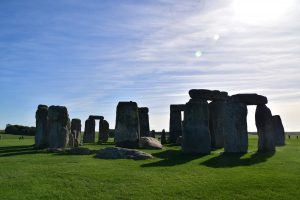
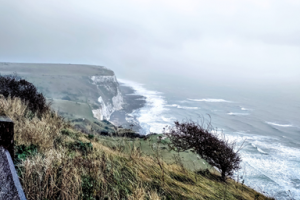
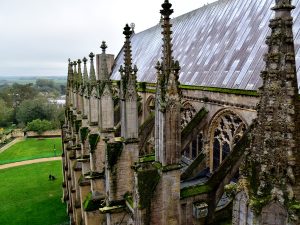
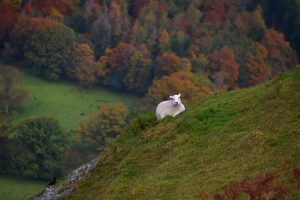
Leave a Reply